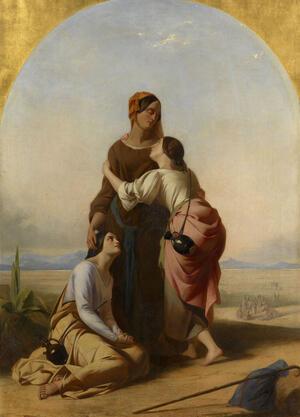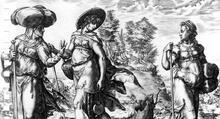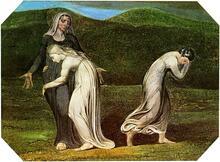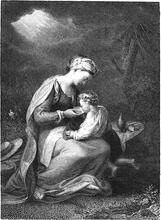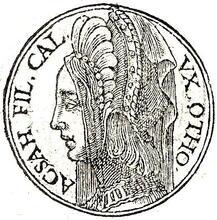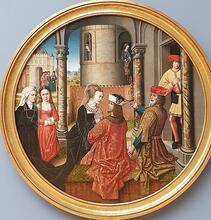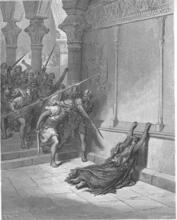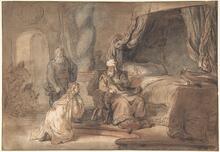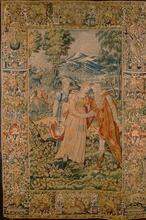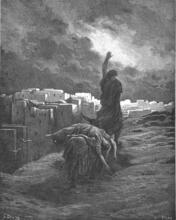Orpah: Midrash and Aggadah
Orpah is one of the secondary characters of the Book of Ruth, which tells the reader only that she was Naomi’s second daughter-in-law. Like her sister-in-law Ruth, she initially wanted to accompany Naomi and return with her to her land. Unlike Ruth, she finally accepted her mother-in-law’s arguments and went back to Moab. The Rabbinic expansion of this narrative, which relates both to Orpah’s actions and to her descendants, paints her in a generally unfavorable light. This dislike is based on Orpah’s comparison to Ruth, in which Orpah is portrayed as the negative version of her sister-in-law. Orpah’s naming reflects the description that she is promiscuous and brazen.
Family
The Rabbis maintain that Orpah and Ruth were sisters, the daughters of King Eglon of Moab (Ruth Rabbah 2:9) who, in turn (according to the same A type of non-halakhic literary activitiy of the Rabbis for interpreting non-legal material according to special principles of interpretation (hermeneutical rules).midrash), was the son of Balak. Ruth’s descent from these kings is regarded as a mark of their merit, while no mention is made of Orpah in this context.
R. Meir emphasizes the fact that Orpah and Ruth did not convert during their marriages to the two brothers but remained Moabitesses, which is one of the reasons given for the punishment meted out to the brothers (Ruth Rabbah 2:9); another tradition has them converting during the course of their marriages but maintains that Orpah returned to her people and her god (Zohar Hadash, Ruth, 78a). The negative attitude to Orpah is also reflected in the fact that her husband Chilion is depicted more unfavorably than his brother Mahlon (related to the word mehilah, pardon), Ruth’s husband. Chilion’s name is given the etymology of kelayah, destruction, and, adding to his disgrace, the Philistine Goliath, who was killed by David, issued from Orpah (Ruth Zuta 1).
The Rabbis identify the Orpah mentioned in the Book of Ruth with the Raphah (or Harafah), the mother of the four warriors of Gath who appear in II Sam. 21, and the Goliath from Gath (Harafah’s son), with the Goliath who fought David in I Sam. 17. According to this identification, both Goliath and the other warriors are therefore Orpah’s children. These men with their special powers were the recompense for the manner in which Orpah parted from Naomi.
In the version of the midrash in BT Sanhedrin (fol. 95a), Orpah also aided her son, Ishbi-benob, in his battle with David and Abishai, and even died during the course of this fight. BT Sotah connects the death of the sons of Orpah at the hands of David and his servants with these opponents’ respective mothers, Orpah (“And Orpah kissed her mother-in-law”—Ruth 1:14) and Ruth (“But Ruth clung to her”—ibid.): “May the sons of the one who kissed come and fall by the hand of the sons of the one who clung” (BT Sotah 42b).
Actions
Orpah’s departure from Naomi is seen as proper and she and her offspring were rewarded for the considerable way that she accompanied Naomi (BT Suspected adulteressSotah 42b). However, once she had taken her leave of her mother-in-law, her subsequent actions are deemed extremely negative. She is said to have lain, that very night, with one hundred men, and even with a dog. The Philistine Goliath, who fought the young David during the battle in the valley of Elah, was born of this promiscuous activity. (Ruth Rabbah 2:20). Orpah’s wanton behavior is said to be characteristic of her and one of the exegeses of her name describes such conduct: “Orpah—because everyone ground her like bruised corn [harifot]” (BT Sotah loc. cit.).
Name
The Rabbis offer different explanations for Orpah’s name, in accordance with the various facets of her character. One interpretation is appropriate for the tableau in the Bible: she is called Orpah because she turned her back (oref) on her mother-in-law (Ruth Rabbah 2:9). Thus, her action is in keeping with her character and reveals her true personality. Additional etymological explanations are likewise connected with her deeds: “It is written [in II Sam. 21:18]: ‘Harafah,’ and it is written [in Ruth 1:4]: ‘Orpah’: Rav and Samuel: One said that her name was Harafah, then why was she called ‘Orpah’? Because everyone engaged in intercourse with her from the rear [orfin]; and the other said: Her name was Orpah, then why was she called ‘Harafah’? because everyone ground her like bruised corn [harifot]” (BT Sotah 42b). These dicta portray Orpah as a woman who behaved wantonly. And also: “[She was named] Orpah, for she deserved to have her neck broken [because of her actions], like the heifer who is so treated” (Ruth Zuta 1:4; although the specific act to which this criticism is directed is not given by the midrash).
The reason why the Rabbis depict Orpah in such a negative light apparently lies in their perception of her as the antagonist of Ruth. They are presented as sisters, which merely intensifies the difference between them. From the moment of their parting, Orpah becomes the negative of Ruth. The Rabbis present the latter as a paragon of modesty (see the entry: “Ruth”), while Orpah becomes a symbol of promiscuity. Ruth is the mother of David; Orpah is the mother of Goliath. Ruth adheres to Israel and thereby adopts all its positive qualities, even becoming the mother of the Israelite royal line; Orpah returns to Moab, thus reverting to being a Moabitess, estranged from all that is Israelite.
Her lecherous behavior matches that of the Moabite women at Shittim and her children are the enemies who fight all Israel, especially David. “May the sons of the one who kissed come and fall by the hand of the sons of the one who clung”—that is, the sons of Orpah, who kissed her mother-in-law and left her, would fall at the hands of the offspring of Ruth, who clung to her mother-in-law (BT Sotah 42b).

